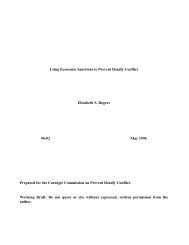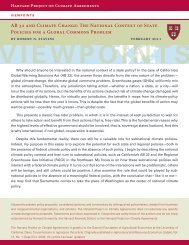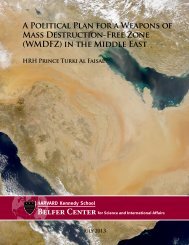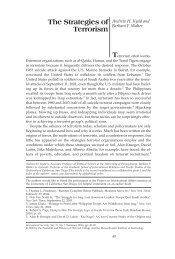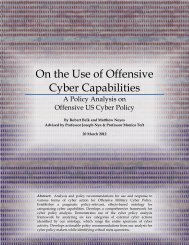Plutonium Mountain - Belfer Center for Science and International ...
Plutonium Mountain - Belfer Center for Science and International ...
Plutonium Mountain - Belfer Center for Science and International ...
- No tags were found...
You also want an ePaper? Increase the reach of your titles
YUMPU automatically turns print PDFs into web optimized ePapers that Google loves.
Though Hecker had not yet given up on finding a way to send the plutonium back to Russia, the<br />
obstacles on the Russian side were high <strong>and</strong> DTRA officials were worried about the costs, so<br />
scientists from the three nations turned their attention to how to secure the plutonium in place.<br />
For the bore holes still containing plutonium residue, inspiration came from the aftermath of the<br />
worst nuclear accident in history. Following the meltdown of a reactor at the Chernobyl Nuclear<br />
Power Plant in 1986, Soviet scientists constructed a giant concrete dome around the crippled<br />
reactor to halt the release of radiation <strong>and</strong> materials into the atmosphere. The Russians at Semipalatinsk<br />
pointed out that such a sarcophagus could work equally well <strong>for</strong> the shallow bore holes.<br />
The scientists thought a giant concrete envelope over the site might deter most scavengers from<br />
breaking into the bore holes. 52 And even if it didn’t—the scavengers had already proven themselves<br />
remarkably determined—violating the dome would require a large industrial enterprise<br />
that could be quickly identifiable by basic monitoring techniques.<br />
Operation Groundhog, as the dome construction ef<strong>for</strong>t was known, was to get underway in August<br />
2000 with funding from the U.S. Cooperative Threat Reduction (CTR) program <strong>and</strong> with<br />
oversight from the U.S. Defense Threat Reduction Agency. But very soon the operation ran into<br />
delays. All work at Semipalatinsk ceased during the winter, when temperatures in eastern Kazakhstan<br />
regularly plummet to -40°C. Only a few months after Operation Groundhog began,<br />
the Kazakh crews put down their tools. When they returned to work in the spring of 2001, U.S.<br />
financial support <strong>for</strong> the project had been suspended. There were several reasons <strong>for</strong> the funding<br />
pause. The newly arrived Bush administration had ordered a complete review of the CTR<br />
program, which led to delays in 2001. Also, the administration carried out a “re-notification” to<br />
Congress of a shift in funds, a st<strong>and</strong>ard procedure, which also resulted in delays. The administration<br />
further had to certify to Congress that Kazakhstan was eligible to receive CTR money, but<br />
the overall umbrella agreement between the United States <strong>and</strong> Kazakhstan, signed in December<br />
1993, had lapsed at the end of 2000. A new agreement wasn’t approved by the Kazakh parliament<br />
until mid-2002. 53<br />
In the summer of 2001, scavengers returned to one of the test sites. 54 The only security put in<br />
place at the site in 2000 was a barbed-wire fence, which “did not provide the expected effect,”<br />
Stepanyuk recalled.<br />
52<br />
The concrete structure also contained an irrigation system, including a drain-pipe <strong>and</strong> external water stop to prevent the material<br />
from leeching into the water table. It should be noted that the concrete sarcophagus at Balapan was much smaller than Chernobyl—it<br />
contained 2075 cubic meters of concrete, compared to 400,000 cubic meters at the Ukrainian reactor. See Stepanyuk,<br />
“Liquidation of Consequences.”<br />
53<br />
Between January <strong>and</strong> July 2002, CTR work in Kazakhstan remained at a st<strong>and</strong>still, in part because the country’s new criminal<br />
code required that all such agreements be extended by parliamentary ratification only. In the ensuing debate over ratification,<br />
some parliamentarians expressed concern that the framework agreement might allow the 41 firms serving as subcontractors to<br />
avoid paying taxes on non-CTR-related transactions. The lower house approved the umbrella agreement in April, 2002, <strong>and</strong> the<br />
upper house in May. See: Nuclear Threat Initiative, “Kazakhstan Nuclear Chronology,” pg. 16. http://www.nti.org/media/pdfs/kazakhstan_nuclear.pdf_=1316466791<br />
(accessed on August 7, 2013). On the 2001 delays, the authors received in<strong>for</strong>mation from a<br />
senior Defense Department official, <strong>and</strong> also relied upon: John Booker, “Overview of Fissile <strong>and</strong> Radioactive Material Proliferation<br />
Prevention (FRMPP) Program: Operation Saiga, Operation Groundhog,” Defense Threat Reduction Agency, 15 July, 2002,<br />
provided by the Defense Department.<br />
54<br />
Ristvet <strong>and</strong> other U.S. officials interviewed suspect that the scavengers were likely the same construction crews that had<br />
worked on constructing the dome the previous year. According to Ristvet, DTRA officials encountered scavengers brazenly using<br />
Degelen <strong>Mountain</strong> Enterprises mining equipment, though Ristvet could never prove that the company’s management was aware<br />
of such security breaches.<br />
20<br />
<strong>Plutonium</strong> <strong>Mountain</strong>: Inside the 17-year mission to secure a dangerous legacy of Soviet nuclear testing



